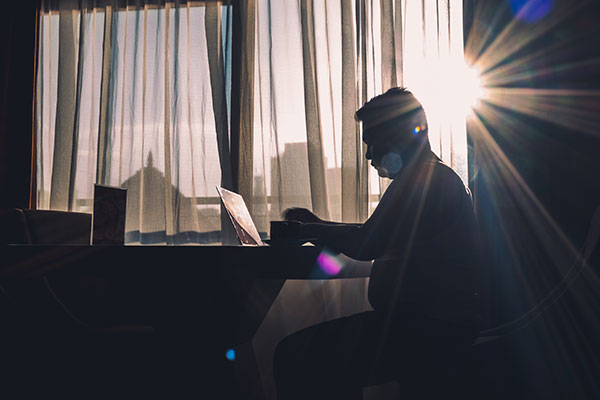 Photophobia, also known as light sensitivity, is a common complaint for our patients at Lang Family Eye Care. It affects both adults and children and can be caused by several factors. Thankfully, several ways exist to prevent and manage it so it doesn’t interfere with your life. If you or your child is experiencing photophobia, you may be looking for answers. Let our friendly Lang Family Eye Care eye doctors shed some light on the situation!
Photophobia, also known as light sensitivity, is a common complaint for our patients at Lang Family Eye Care. It affects both adults and children and can be caused by several factors. Thankfully, several ways exist to prevent and manage it so it doesn’t interfere with your life. If you or your child is experiencing photophobia, you may be looking for answers. Let our friendly Lang Family Eye Care eye doctors shed some light on the situation!
What is photophobia?
Photophobia is not a disease in itself but rather a symptom of various conditions affecting the neurological system, eyes, and mental health. While this symptom can often seem harmless, its persistent presence could signal more serious health issues that may require medical attention.
Derived from Greek words meaning “fear of light,” it’s a sensory disturbance triggered by light. Various medical conditions can cause this condition, from eye issues to central nervous system disorders and psychiatric conditions. Those with photophobia perceive even ordinary light as blindingly bright or experiencing pain in its presence. While everyone has some level of sensitivity to light, for people with photophobia, the struggle is constant and severe. Even everyday levels of brightness can be excruciatingly painful.
Different factors affect photophobia symptoms. Bright artificial light usually leads to more discomfort. Surprisingly, certain colors, like blue light, can be particularly triggering to light sensitivity. That means your home or office lighting can also exacerbate symptoms, making warm tones feel colder and outside lights seem even brighter.
What are the signs and symptoms of photophobia?
Symptoms of photophobia range from squinting and blinking frequently to discomfort under strong sunlight or bright indoor lighting conditions. You may prefer cloudy days over sunny ones, dimly lit rooms over brightly lit ones, and going out after dusk rather than during the day due to discomfort caused by brightness.
Photophobia in children often manifests with several signs. These include indications of eye pain or swelling, persistent touching of the eyes due to itchiness, and complaints of headaches, blurred vision, and neck stiffness. Severe signs include excessive squinting and dizziness or nausea, especially in bright conditions. Different levels of severity can trigger varying reactions in children. Some may vocalize their discomfort and stress, while others may show agitation and a higher propensity for tantrums.
What are the most common causes of photophobia?
The most common causes of light sensitivity fall under four categories: neurological, eye conditions, psychological, and medication-related.
Neurological:
Migraine headaches are among the most common neurological disorders that may result in photophobia. 80-90% of people with migraines experience moderate to severe photophobia, sometimes in the absence of an active headache. In fact, photophobia is such a common symptom in individuals with migraines that it is used as a diagnostic criterion by healthcare professionals. Other neurological conditions that could lead to photophobia include blepharospasm, traumatic brain injuries, and meningitis.
Eye Conditions:
A variety of eye conditions can cause photophobia, including dilated pupils, dry eye, eye sunburn, conjunctivitis, keratitis, corneal abrasion, iritis or uveitis, retinal damage, glaucoma, cataracts, post-eye surgery effects, and blepharospasm. All these conditions can alter the eye’s response to light, causing discomfort or even pain.
In the realm of eye conditions, dry eyes are the most common cause of photophobia. This condition arises when tear production fails to provide sufficient lubrication for the eyes. If we discover any dryness during your eye exam at Lang Family Eye Care, we may suggest artificial tears, tear duct blockers (punctal plugs), medication, or other therapies to alleviate your symptoms.
Additionally, photophobia may also manifest due to other eye-related conditions such as conjunctivitis, corneal disease, optic neuritis, and uveitis. If your eye exam reveals any of these conditions, your Lang Family Eye Care eye doctor will discuss treatment options with you.
In addition to these eye conditions, problems within the visual system can trigger photophobia. Persistent photophobia that is not linked to a particular ocular or medical condition may arise from a disruption between the eye’s light-detecting cells and the optic nerve. Equally, a disruption of the eye-brain connections resulting in eye misalignment could contribute to the condition.
Aside from the discomfort it causes, the underlying causes of photophobia could potentially lead to further complications if untreated. If you’re experiencing heightened light sensitivity, scheduling an eye exam at Lang Family Eye Care is important so we can rule out any serious eye or medical conditions.
Psychological:
Some psychological conditions also hold the potential for causing photophobia. For instance, agoraphobia, depression, anxiety, and panic disorders may all cause photophobia in some individuals. If you have been diagnosed with any of these conditions and are experiencing light sensitivity, you may want to speak with your mental health provider to determine if there is a connection.
Medications:
Furthermore, certain medications known to prompt photosensitivity as a side effect can lead to photophobia. These include benzodiazepines like diazepam (Valium), sedative drugs like amobarbital (Amytal), haloperidol (Haldol) used to treat mental health conditions, and antimalarial medication such as chloroquine (Aralen).
Diagnosis
Our Lang Family Eye Care team has a comprehensive method to diagnose photosensitivity, which begins with a detailed look at your health history. If your history includes migraines, it’s quite likely they play a part in your photophobia.
One of the first things we will check for is dry eyes. This usually involves performing Schirmer testing and checking for iritis, uveitis, and corneal staining. Our comprehensive examination may also test for underlying issues like blepharitis or corneal erosion and assess your blinking pattern.
A topical anesthetic is sometimes applied to determine its effect on light sensitivity. If this eases the sensitivity, it could indicate that the condition is localized, such as dry eyes or corneal neuropathy. Conversely, if the anesthetic does not alleviate the sensitivity, it could be a sign of hemeralopia or nyctalopia, suggesting retinal problems.
Lang Family Eye Care leaves no stone unturned when searching for answers for you or your child’s extreme light sensitivity. If we are unable to find an ophthalmological reason for your symptoms, we may refer you to your primary care doctor for further examination.
Treatments for Photophobia
Photophobia treatment varies depending on its cause. Some options may include:
Glasses for Light Sensitivity
 If you suffer from light sensitivity, certain types of eyewear could provide some relief. Several types of light-sensitivity glasses are designed to alleviate the discomfort caused by bright light, glare, and reflections.
If you suffer from light sensitivity, certain types of eyewear could provide some relief. Several types of light-sensitivity glasses are designed to alleviate the discomfort caused by bright light, glare, and reflections.
Anti-glare Lenses:
First on the list are anti-glare lenses. These glasses reduce glare off reflective surfaces such as digital screens and buildings. By alleviating discomfort and eye strain caused by glare, these lenses are ideal for those who routinely deal with reflections from bright lights.
Photochromatic Lenses:
Also known as transition lenses, these glasses automatically darken upon exposure to bright light, like the sun, and lighten under dimmer light conditions. If you frequently transition between bright outdoor light and dim indoor environments, photochromatic lenses could prove beneficial.
Blue Block Lenses:
Blue Block lenses are designed to block blue light emitted from digital devices, thus lowering eye strain, headaches, dry eyes, and disruption to your circadian rhythm.
Polarized Lenses:
These lenses have a special polarizing film to reduce glare and limit the light that reaches your eyes. Particularly useful for individuals sensitive to glare, polarized lenses are commonly integrated into polarized sunglasses, making them ideal for driving or partaking in outdoor activities.
Tinted Lenses:
Tinted lenses come in shades of yellow, amber, or brown to dial down the amount of bright light that enters the eyes. If you have light sensitivity resulting from migraines or other conditions, tinted lenses may offer relief.
Wrap-around Lenses:
Wrap-around glasses contour the sides of the eyes to restrict lateral light entry, providing a comprehensive light-blocking solution.
FL-41 Lenses:
These unique, rose-colored tints were initially developed to reduce eye discomfort under the harsh impact of fluorescent lights. FL-41 filters, with their characteristic tint, effectively alleviate photophobia and, in some scenarios, migraines, by interrupting these specific light waves from reaching the eye.
Addressing Dry Eyes
Interestingly, individuals who suffer from migraines often report more problems concerning dry eyes or symptoms that simulate dry eyes. Dry eyes can indeed exacerbate blurry vision and photophobia. Introducing simple lubricating eye drops could give you significant light sensitivity relief. If regular eye drops do not alleviate the issue, we may try tear duct blockers or other prescription medications.
Medications
Medications can be particularly useful for photophobia in migraine sufferers. In the pharmaceutical realm, anti-CGRP medications have been found to reduce the occurrence of photophobia and other sensory symptoms, apart from decreasing the total number of “headache days.”
Trypotamine-based medications, or triptans, have been in use for several decades for acute migraine treatments. They may not prevent light-sensitive reactions over time, but they are effective in relieving photophobia within the first few hours of a migraine attack.
Transcutaneous electrical nerve stimulation (TENS), a form of neuromodulation, is another treatment for photophobia. Using electrical currents delivered through the skin, this method mediates pain and sensory responses from the nervous system.
Finally, over-the-counter pain-relieving drugs like acetaminophen and pilocarpine may provide short-term relief for acute photophobia symptoms. However, these options may not be effective for chronic conditions or long-term use.
Behavioral Changes
In addition to tinted glasses and medications, there are several ways you can ease the symptoms of light sensitivity at home:
Change Your Lighting
It’s important to favor natural light over fluorescent lighting, which is known to cause discomfort for people with photophobia. A simple switch from fluorescent lights to incandescent bulbs or warm white LEDs can significantly improve your eye comfort.
Secondly, employing dimmers on your indoor lighting can provide a comfortable and adjustable light source that doesn’t overwhelm your eyes. Being able to control the brightness of your indoor lighting enables you to personalize your lighting environment based on your comfort level.
Limit Blue Light
 A significant portion of the visible light spectrum is comprised of blue light, which vibrates within the 380 to 500 nanometer range. Our primary source of blue light is the sun, but many artificial sources also emit blue light, such as fluorescent lights, LED TVs, computer monitors, smartphones, and tablet screens.
A significant portion of the visible light spectrum is comprised of blue light, which vibrates within the 380 to 500 nanometer range. Our primary source of blue light is the sun, but many artificial sources also emit blue light, such as fluorescent lights, LED TVs, computer monitors, smartphones, and tablet screens.
Our eyes struggle to block blue light effectively. Consequently, nearly all visible blue light reaches the retina, which could lead to retinal cell damage and vision issues such as age-related macular degeneration over time. Other potential threats include cataracts, eye cancer, and growths on the eye’s clear covering. Alarmingly, children face a higher risk than adults, as their eyes absorb larger amounts of blue light from digital devices.
Blue light glasses may offer relief for those experiencing digital eye strain due to prolonged use of digital devices. Additionally, adhere to the 20-20-20 rule to alleviate digital eye strain. Every 20 minutes, take a 20-second break to look at something 20 feet away. Read our article about Digital Eye Strain for more information on our screen’s harmful effects on our eyes.
Adjust Screen Settings
Tech devices such as cell phones, televisions, and computer monitors can also contribute to photophobia. Use their built-in light adjustment settings to manage the brightness and color, creating an easier viewing experience. You can also use blue light glasses to make looking at a screen more comfortable or install blue light filters on your smartphone, tablet, and computer screen. These filters block harmful blue light from reaching your eyes without compromising display visibility.
Maintain a controlled lighting environment and reduce device screen glare. Establish an effective working distance and posture for screen viewing and ensure any vision impairments are adequately corrected. If you have other vision dysfunctions like myopia, your Lang Family Eye Care eye doctor will talk to you about the best way to manage your symptoms.
Wear Sunglasses or a Hat
There’s no reason to let the bright sunlight keep you indoors. Wearing polarized sunglasses can protect your eyes from harsh sunlight. However, it’s important to note that sunglasses should not be worn indoors. While they might offer temporary relief, over the long term, they can darken-adapt your eyes, making your photophobia worse.
A hat or cap can also provide additional shade for your eyes when outdoors, further helping to reduce light sensitivity.
How can photophobia be prevented?
 While it’s not always possible to completely prevent photophobia, several precautions can be taken to minimize your risk.
While it’s not always possible to completely prevent photophobia, several precautions can be taken to minimize your risk.
The first step to preventing photophobia is understanding the triggers that cause your discomfort. For instance, if you frequently experience migraines, it’s crucial to identify and avoid the triggers that lead to these disabling headache attacks. This could range from specific foods, changes in weather, lack of sleep, or stress, among others. By managing these triggers, you can effectively reduce the frequency of migraines and, subsequently, the occurrence of light sensitivity.
Conjunctivitis can cause photophobia and is often a result of bacterial or viral infection, allergy, or exposure to irritants. The most effective way to prevent conjunctivitis is by practicing good hygiene, not touching your eyes, or sharing makeup. Children are especially prone to pink eye, so teach your children good eye hygiene habits.
In rare cases, meningitis or encephalitis can cause photophobia. Meningitis is an inflammation of the protective membranes of the brain and spinal cord that can be life-threatening and require immediate medical attention. It can be prevented by avoiding close contact with people who are infected, washing your hands regularly, and getting vaccinated against bacterial meningitis. Encephalitis is an inflammation of the brain that can cause photophobia and is often caused by viral infection. The best way to keep encephalitis at bay is by frequently washing your hands and getting vaccinated. Moreover, avoiding exposure to mosquitoes and ticks, which can carry viruses that cause encephalitis, is also a crucial preventive measure.
Step Into the Light With Lang Family Eye Care
Bright light doesn’t have to leave you in pain. If you’re experiencing light sensitivity, schedule an appointment at Lang Family Eye Care for an exam. Because photosensitivity has a number of potential causes and links to other health conditions, it’s important to get your symptoms checked early. We have many partnerships with other providers in the area if the source of your photophobia is not related to an eye condition. If it is, we offer many treatment options and ways to address other eye health concerns.
If you’ve been hiding in the dark due to painful light sensitivity, it’s time to come into the soothing light of our Lang Family Eye Care office in New Berlin!
Share this article:

